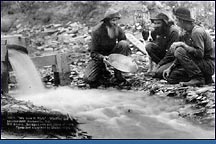| Why it happened |
| The Sioux Indians
became upset when the Whites started using this trail. The reason
was the trail went straight through their traditional buffalo hunting
grounds. The Sioux became even more furious in 1865 when Brig.
Gen. Patrick E. Conner had received orders to build a fort on the
Bozeman Trail. Calling it Camp Conner after himself, it was later
renamed Fort Reno.
This Fort was built to protect
settlers traveling to the gold fields from Indian attacks. The
Sioux Indian Chiefs were determined to keep the trail closed.
|
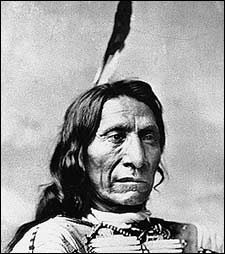 |
|
Later in the year, U.S. soldiers
were sent to protect the trail. Colonel Henry Bebee Carrington,
from Connecticut, was ordered to staff Fort Reno and build two
additional forts farther north. One of these forts will be later
called Fort Phil Kearny, named after Maj. Gen. Phillip Kearny who
died earlier in the year. The
arrival of Carrington and troops didn't set will with Chief Red Cloud
and the Sioux, especially since white men were asking to use the trail
after they already built the forts. Red Cloud and the Sioux vowed
to kill any white men who used the Bozeman Trail. |
|
| The Fort |
| Fort Phil Kearny sat
on a plateau between Big and Little Piney Creeks. Carrington set
up a lookout post some 50 meters away to signal for danger when help was
needed on the trail. The fort was 600 ft. by 800 ft. The
last of the fort was completed by December. |
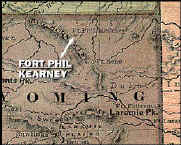 |
|
| About
Carrington |
| Carrington was known
for being a coward. His strengths were design and engineering. In
other words, he could come up with good plans but couldn't go through
with them.
Carrington built another fort the
next year some 90 miles NW of Fort Phil Kearny named Fort C.F. Smith. |
|
| Attacks on
the Wood trains |
| A wood train was
attacked on December 6th. The lookouts signaled for help.
Carrington, along with some twenty other men , were sent out to relieve
the wood train. As soon as the cavalry arrived they were met by an
ambush of Indians. The cavalry retreated with only two dead and
five wounded. The wood train attack was a decoy to try to lead the
cavalry to follow the warriors to the thousands of Indians waiting on
the other side of the ridge. Carrington, as bright as he was,
figured out their plan and gave the orders that NO
men were to chase after the Indians.
|
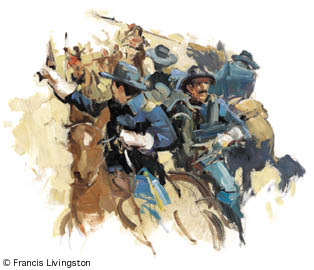
|
| Another attack on the wood trains
followed the December 19th. This time, the commanding officer was
Captain Powel. He was ordered to relieve the wood train like Carrington
was supposed to before. Powell followed orders and didn't follow the
Indians. |
|
| The Last
Attack |
| Just two days later on
December 21, was the worst attack so far on the wood trains. Like
before, orders were given to "Relieve the wood train and report
back. Under no circumstances, pursue the Indians beyond Lodge
Trail Ridge." The orders at first were given to Powell, but
Capt. William Judd Fetterman, eager to fight, called seniority over
Powell. Carrington apparently repeated the order three more
times. Fetterman received 80 men for this attack. On
coincidence perhaps, since he once boasted, "Give me 80 men and I
can ride through the whole Sioux nation."
When Fetterman arrived at the
attack, decoys were standing on the edge of Lodge Trail Ridge gesturing
them to follow. Fetterman and troops headed for the ridge not
knowing that one to two thousand Indians were waiting for him
below. The wagon, by the way, made it back safely to the
fort.
|
|
| The Fight
Begins |
| At the top of the
ridge, the soldiers looked down and only saw a handful of Indians.
The soldiers ran down to start the fight . The decoys had done their
job.
All of a sudden, about a thousand
Indians rose out of the tall grass. Some soldiers began to flee, some
took cover behind rocks from the estimated 40,000 arrows, others took a stand.
They were separated into three different groups. Some Indian
witnesses believed that Fetterman was one of the few who took a stand.
|
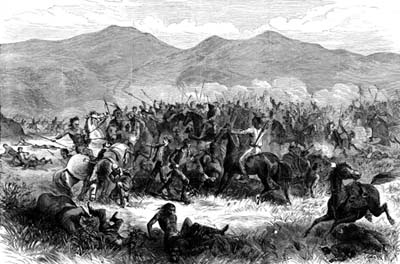 |
| The soldiers fought with whatever
they could: knives , bayonets, guns, and when their bullets ran out,
their gunstocks! Seventy-nine men were killed before the Indians
made their last move. Fetterman and Capt. Fred Brown were the only
two alive up till that point. Fetterman and Brown placed their
pistols to each others head and fired before the Indians had time to
kill them in a slower, more painful death. |
|
| After the
fight |
| All Eighty-one men
were killed within 40 minutes. The Sioux, Cheyenne, and Arapaho
Indians that were involved in the fight, counted coup in wholesale
numbers. Not many Indians died of their thousands, only about 60.
The Indians celebrated afterward
by scalping and mutilating the bodies. They cut off their noses,
ears, fingers, hands, and other body parts. They gouged out their
eyeballs, mashed their brains, and left their entrails lying on
rocks. They did all this so their spirits would remain helpless in
the spiritual afterworld. |
|
| Rescue too
Late |
| After hearing the gunshots, Carrington
sent Captain Tenoder Ten Eych and men to help out the rescue
party. Instead they ended up being the rescuers. When they
arrived there the fight was over. The fight took place some four
miles from Fort Phil Kearny. The Indians saw them on top of the
ridge and gestured them to come down. Ten Eych followed orders and
ignored them as he watched in horror to what was happening to his
friends and fellow soldiers below. After the Indians were finished
the soldiers collected as many bodies as they could, at the time only 49
of them. |
|
| About Fetterman |
| Fetterman was born in
1833?-1866. In 1861, he enlisted in the army from Delaware.
He was twice brevetted for gallant conduct. He was a Civil War
hero as well as an American army officer. He was sent to Fort Phil
Kearny in Wyoming on Nov. 1866. He hated the Indians as much as
Custer. He boasted that with 80 men he could ride through the
whole Sioux nation. He used to be an officer of the 18th
infantry. Fetterman believed in himself and in traditional
military strategy. He was 31 yrs of age at the time of the
Fetterman Fight. |
|
| After Phase of the Fight |
| The situation at Bozeman Trail became
worse after the Fetterman Fight. The Indians attacked more
often. The next year, on Aug. 1868, General Washington ordered all
three of the forts to be abandoned. The Indians burned all three
forts to the ground. Chief Red Cloud signed a peace treaty
on Nov. 6 which stated that the whites were not allowed to use the
Bozeman Trail anymore. The Indians got just what they
wanted. |
|
| Facts of Fetterman Fight |
| -Occurred on Dec. 21 1866 in Powder
River Country in Northern Wyoming
-US Army led by William Judd Fetterman
-Indians led by Chief Red Cloud
-Known as the worst military blunder prior to
Little Big Horn
-Military defeat |
|
This is the memorial for the 81 men
killed four miles from Fort Kearny in the bloody Fetterman Fight on
December 21, 1866 in which all men were killed. |
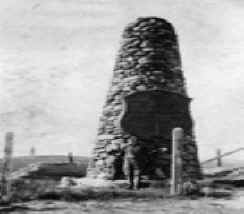 |
|
|

